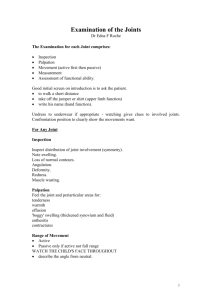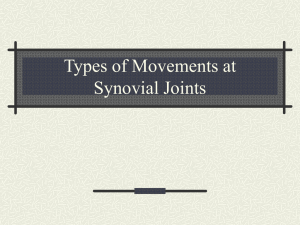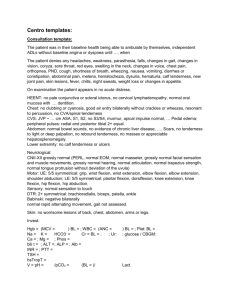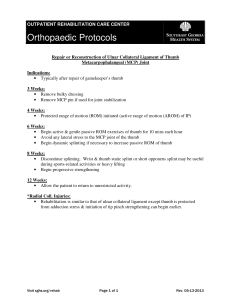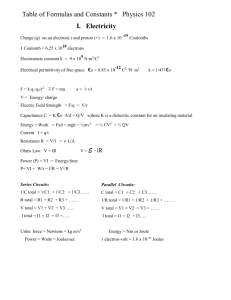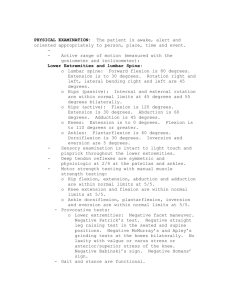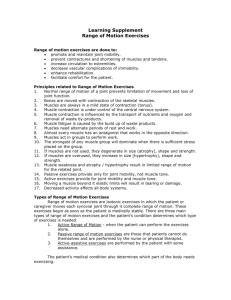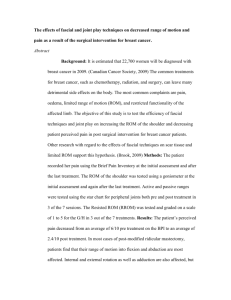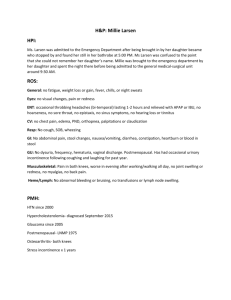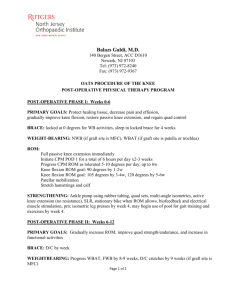Assessment of the Musculoskeletal System
advertisement
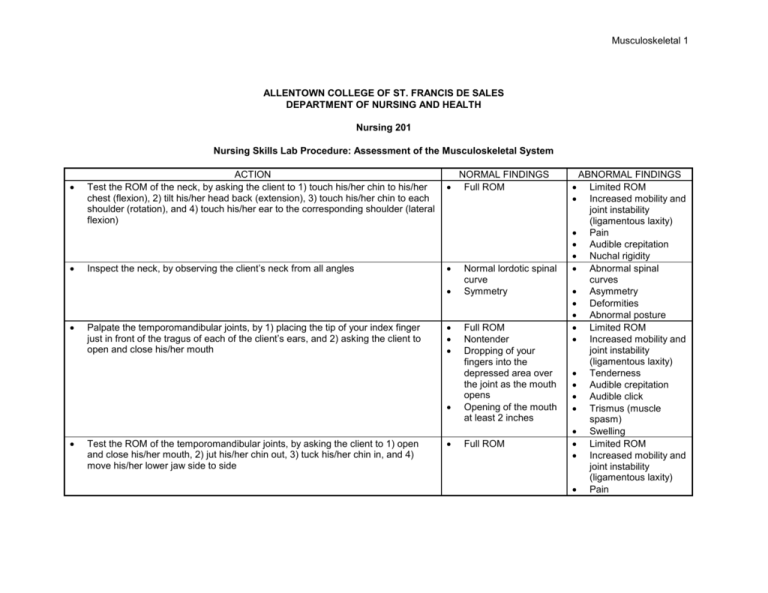
Musculoskeletal 1 ALLENTOWN COLLEGE OF ST. FRANCIS DE SALES DEPARTMENT OF NURSING AND HEALTH Nursing 201 Nursing Skills Lab Procedure: Assessment of the Musculoskeletal System ACTION Test the ROM of the neck, by asking the client to 1) touch his/her chin to his/her chest (flexion), 2) tilt his/her head back (extension), 3) touch his/her chin to each shoulder (rotation), and 4) touch his/her ear to the corresponding shoulder (lateral flexion) NORMAL FINDINGS Full ROM Inspect the neck, by observing the client’s neck from all angles Palpate the temporomandibular joints, by 1) placing the tip of your index finger just in front of the tragus of each of the client’s ears, and 2) asking the client to open and close his/her mouth Test the ROM of the temporomandibular joints, by asking the client to 1) open and close his/her mouth, 2) jut his/her chin out, 3) tuck his/her chin in, and 4) move his/her lower jaw side to side Normal lordotic spinal curve Symmetry Full ROM Nontender Dropping of your fingers into the depressed area over the joint as the mouth opens Opening of the mouth at least 2 inches Full ROM ABNORMAL FINDINGS Limited ROM Increased mobility and joint instability (ligamentous laxity) Pain Audible crepitation Nuchal rigidity Abnormal spinal curves Asymmetry Deformities Abnormal posture Limited ROM Increased mobility and joint instability (ligamentous laxity) Tenderness Audible crepitation Audible click Trismus (muscle spasm) Swelling Limited ROM Increased mobility and joint instability (ligamentous laxity) Pain Musculoskeletal 2 Audible crepitation Palpate the spinous processes of the cervical spine, by 1) placing the thumb of your right hand on one side of each spinous process, and 2) placing the index finger of your right hand on the other side of each spinous process Palpate the trapezius muscles and muscles between the scapulae Test the ROM of the hands and wrists, by asking the client to 1) make a fist with each hand with his/her thumb across the knuckles (flexion, adduction, opposition of the thumb), 2) open the fist and spread the fingers of each hand (extension, abduction), 3) raise and lower each hand at the wrist (flexion, extension), and 4) deviate each hand toward the thumb and the little finger (radial deviation, ulnar deviation) Nontender Tenderness Nontender Full ROM Inspect the hands and wrists, by observing the client’s hands and wrists from all angles Symmetry Palpate the proximal and distal interphalangeal joints of the right hand, by 1) placing the thumb of your right hand on the medial aspect of each proximal and distal interphalangeal joint of the client’s right hand, and 2) placing the index finger of your right hand on the lateral aspect of each proximal and distal interphalangeal joint of the client’s right hand (Reverse to palpate the proximal and distal interphalangeal joints of the left hand) Test for tenderness of the metacarpophalangeal joints of the right hand, by 1) placing the thumb and fingers of your right hand around the client’s right hand, just proximal to the metacarpophalageal joints, and 2) compressing the metacarpophalangeal joints of the client’s right hand with the thumb and fingers of your right hand (Reverse to test for tenderness of the metacarpophalangeal joints of the left hand) Palpate the metacarpophalangeal joints, by placing the thumbs of your right and left hands just distal to, and on each side of, each of the client’s knuckles Nontender Tenderness Limited ROM Increased mobility and joint instability (ligamentous laxity) Pain Audible crepitation Asymmetry Swelling Redness Nodules Deformities Muscular atrophy Tenderness Swelling Bogginess Bony enlargement Nontender Tenderness Swelling Bogginess Nontender Palpate the wrist joint of the right hand, by 1) placing the thumbs of your right and left hands on the dorsal (top) surface of the client’s right wrist, and 2) placing your Nontender Tenderness Swelling Bogginess Tenderness Swelling Musculoskeletal 3 fingers of your right and left hands on the palmar (bottom) surface of the client’s right wrist (Reverse to palpate the left wrist joint) Test the ROM of the right elbow, by asking the client to 1) bend his/her right elbow (flexion), 2) straighten his/her right elbow (extension), 3) turn the palm of his/her right hand up (supination), and 4) turn the palm of his/her right hand down (pronation) (Reverse to test ROM of the left elbow) Bogginess Full ROM Limited ROM Increased mobility and joint instability (ligamentous laxity) Pain Audible crepitation Nodules Swelling Thickening Tenderness Palpate the right elbow, by 1) standing at an oblique right angle to the client, 2) supporting the client’s right forearm with your left hand so that his/her elbow is flexed to 70º, 3) placing the thumb of your right hand 10 centimeters proximal to and on one side of the client’s right elbow, 4) placing the fingers of your right hand 10 centimeters proximal to and on the other side of the client’s right elbow, and 5) moving your right thumb and fingers distally in progressive steps along the sides of the client’s right elbow (Reverse to palpate the left elbow) Test the ROM of the shoulders, by asking the client to 1) raise both of his/her arms to a vertical position at the sides of his/her head (flexion), 2) lower both of his/her arms to his/her sides (extension), 3) place both of his/her hands behind his/her neck with both of his/her elbows out to the side (external rotation, abduction), and 4) place both of his/her hands behind the small of his/her back with both of his/her elbows out to the side (internal rotation, adduction) Nontender Full ROM Inspect the shoulders anteriorly, by 1) standing directly in front of the client, and 2) observing the client’s shoulders anteriorly from all angles Symmetry Inspect the shoulders posteriorly, by 1) standing directly behind the client, and 2) observing the client’s shoulders posteriorly from all angles Symmetry Test the ROM of the right ankle and foot, by 1) having the client lie down on an examining table, 2) asking the client to point the toes of his/her right foot downward (plantar flexion), 3) asking the client to point the toes of his/her right foot towards his/her nose (dorsiflextion), 4) stabilizing the client’s right ankle with one hand, grasping the client’s right heel with your other hand, and turning the sole of the client’s right foot inward (inversion) and outward (eversion) at the Full ROM Limited ROM Increased mobility and joint instability (ligamentous laxity) Pain Audible crepitation Asymmetry Swelling Deformities Muscular atrophy Asymmetry Swelling Deformities Muscular atrophy Limited ROM Increased mobility and joint instability (ligamentous laxity) Pain Audible crepitation Musculoskeletal 4 subtalar joint, 5) stabilizing the client’s right ankle with one hand, grasping the client’s right forefoot with your other hand, and turning the client’s right foot inward (inversion) and outward (eversion) at the transverse tarsal joint, 6) asking the client to curl up the toes of his/her right foot (flexion, adduction), and 7) asking the client to straighten and spread the toes of his/her right foot (extension, abduction) (Reverse to test the ROM of the left ankle and foot) Inspect the ankles and feet, by 1) having the client lie down on an examining table, and 2) observing the client’s ankles and feet from all angles Palpate the achilles tendon of the right ankle, by 1) having the client lie down on an examining table, and 2) feeling along the back of the client’s right ankle (Reverse to palpate the left achilles tendon) Palpate the anterior aspect of the right ankle joint, by 1) having the client lie down on an examining table, 2) placing the thumbs of your right and left hands on the dorsal (top) surface of the client’s right ankle joint, and 3) placing the fingers of your right and left hands on the palmar (bottom) surface of the client’s right ankle joint (Reverse to palpate the left ankle joint) Test for tenderness of the metatarsophalangeal joints of the right foot, by 1) having the client lie down on an examining table, 2) placing the thumb and fingers of your right hand around the client’s right forefoot, just proximal to the metatarsophalageal joints, and 3) compressing the client’s right forefoot between the thumb and fingers of your right hand (Reverse to test for tenderness of the metatarsophalangeal joints of the left foot) Palpate the metatarsophalangeal joints of the right foot, by 1) having the client lie down on an examining table, 2) placing the thumb of your right hand on the dorsal (top) surface of each of the client’s metatarsophalangeal joints of his/her right foot, and 3) placing the index finger of your right hand on the plantar (bottom) surface of each of the client’s metatarsalphalangeal joints in his/her right foot (Reverse to palpate the metatarsalphalangeal joints of the left foot) Test the ROM of the right knee and hip, by 1) having the client lie down on an examining table, 2) asking the client to bend his/her right knee up to his/her chest and pull it firmly against the abdomen (flexion), 3) asking the client to straighten his/her right knee and place it on the examining table (extension), 4) flexing the Symmetry Asymmetry Deformities Nodules Swelling Calluses Corns Tenderness Nodules Nontender Nontender Tenderness Bogginess Swelling Nontender Tenderness Nontender Tenderness Full ROM Limited ROM Increased mobility and joint instability (ligamentous laxity) Musculoskeletal 5 client’s right leg to 90º at the hip and knee, stabilizing the client’s right thigh with one hand, grasping the client’s right ankle with your left hand, and swinging the client’s lower leg inward or medially (external rotation) and outward or laterally (internal rotation), and 5) stabilizing the client’s left pelvis with your left hand, grasping his/her right ankle with your right hand, and pulling his/her right leg away from midline until you feel the client’s left iliac spine move (abduction), and moving his/her right leg toward the midline (adduction) (Reverse to test ROM of the left knee and hip) Inspect the knees, by 1) having the client lie down on an examining table, and 2) observing the client’s knees from all angles Symmetry Pain Audible crepitation Asymmetry Deformities Atrophy of the quadriceps muscle Loss of normal hollows around the patella Swelling Tenderness Warmth Palpate the right knee, by 1) having the client lie down on an examining table, 2) placing the thumb of your right hand 10 centimeters above and proximal to one side of the client’s right kneecap (patella), 3) placing the fingers of your right hand 10 centimeters above and proximal to the other side of the client’s right kneecap (patella), and 4) moving your right thumb and fingers distally in progressive steps along the sides of the client’s right kneecap (patella) (Reverse to palpate the left knee) Test ROM of the spine, by 1) sitting behind the standing client, 2) asking the client to bend forward and touch his/her toes (flexion), 3) asking the client to stand straight up (extension), and 4) stabilizing the client’s pelvis with both of your hands and asking the client to bend to his/her right then left (lateral flexion), bend backwards (hyperextension), and twist his/her shoulders to the right then left (rotation) Nontender Full ROM Inspect the lateral spinal profile, by 1) standing at the side of the standing client, and 2) observing the client’s spinal profile laterally from all angles Inspect the posterior spinal profile, by 1) standing behind the standing client, and 2) observing the client’s spinal profile posteriorly from all angles Normal kyphotic and lordotic spinal curves Normal spinal curves Symmetry (especially of the heights of the shoulders, iliac crests, and skin creases in Limited ROM Increased mobility and joint instability (ligamentous laxity) Pain Audible crepitation Abnormal spinal curves Abnormal spinal curves Asymmetry (especially of the heights of the shoulders, iliac crests, Musculoskeletal 6 the buttocks) Palpate the spinous processes of the thoracic and lumbar spine, by 1) placing the thumb of your right hand on one side of each spinous process of the client’s thoracic and lumbar spine, and 2) placing the index finger of your right hand on the other side of each spinous process of the client’s thoracic spine Palpate the paravertebral muscles of the thoracic and lumbar spine Nontender Nontender and skin creases in the buttocks) Tenderness Tenderness Trismus (muscle spasm) Musculoskeletal 7 FULL RANGE OF MOTION OF THE JOINTS JOINT Temporomandibular Joint Neck Shoulder MOVEMENT TMJ opening DESCRIPTION Open mouth FULL RANGE OF MOTION 3-6 centimeters (1-2.3 inches) TMJ closing Protrusion Retrusion Lateral motion Close mouth Jut chin out Tuck chin in Move jaw from side to side Complete closure Move the head from the upright midline position forward, so that the chin rests on the chest Move the head from the flexed position to the upright position Move the head from the upright position back as far as possible Move the head laterally to the right and left shoulders, while facing front Turn the face as far as possible to the right and left Raise each arm from a position by the side forward and upward to a position beside the head Move each arm from a vertical position beside the head forward and down to a resting position at the side of the body Move each arm from a resting side position to behind the body Move each arm laterally from a resting position at the sides to a side position above the head, palm of the hand away from the head Move each arm from a position 1-2 centimeters (0.3-0.7 inches) from midline 45 from midline Flexion Extension 45 from midline Hyperextension 10 Lateral flexion 40 from midline Rotation 70 from midline Flexion 180 from the side Extension 180 from vertical position beside the head Hyperextension 50 from side position Abduction 180 Adduction (anterior) 230 Musculoskeletal 8 Elbow Adduction (posterior) Horizontal flexion Horizontal extension Circumduction External rotation Internal rotation Flexion Extension Rotation for supination Rotation for pronation beside the head downward laterally and across the front of the body as far as possible Move each arm from a position beside the head downward laterally and across behind the body as far as possible Extend each arm laterally at shoulder height and move it through a horizontal plane across the front of the body as far as possible Extend each arm laterally at shoulder height and move it through a horizontal plane as far behind the body as possible Move each arm forward, up, back, and down in a full circle With each arm held out to the side at the shoulder level and the elbow bent to a right angle, fingers pointing down, move the arm upward so that the fingers point up With each arm held out to the side at shoulder level and the elbow bent to a right angle, fingers pointing up, bring the arm forward and down so that the fingers point down Bring each lower arm forward and upward so that the hand is at the shoulder Bring each arm lower arm forward and downward, straightening the arm Turn each hand and forearm so that the palm is facing upward Turn each hand and forearm so that 230 130 -135 45 360 90 90 150 150 70 - 90 70 - 90 Musculoskeletal 9 Wrist Hands and Fingers Thumb Hip Flexion Extension Hyperextension Radial flexion (abduction) Ulnar flexion (adduction) Flexion Extension Hyperextension Abduction Adduction Flexion Extension Abduction Adduction Opposition Flexion Extension the palm is facing downward Bring the fingers of each hand toward the inner aspect of the forearm Straighten each hand to the same plane as the arm Bend the fingers of each hand back as far as possible Bend each wrist laterally toward the thumb side with hand supinated Bend each wrist laterally toward the fifth finger with the hand supinated Make a fist with each hand Straighten the fingers of each hand Bend the fingers of each hand back as far as possible Spread the fingers of each hand apart Bring the fingers of each hand together Move each thumb across the palmar surface of the hand toward the fifth finger Move each thumb away from the hand Extend each thumb laterally Move each thumb back to the hand Touch each thumb to the tip of each finger of the same hand. The thumb joint movements involved are abduction, rotation, and flexion Move each leg forward and upward. The knee may be extended or flexed Move each leg back beside the 80 - 90 80 - 90 70 - 90 0 - 20 30 - 50 90 90 30 20 20 90 90 30 30 Knee extended, 90; knee flexed, 120 90 - 120 Musculoskeletal 10 Hyperextension Abduction Adduction Circumduction Internal rotation External rotation Flexion Extension Ankle Extension (plantar flexion) Foot and Toes Flexion (dorsiflexion) Eversion Inversion Flexion Extension Abduction Adduction Flexion Extension Hyperextension Lateral flexion Knee Trunk other leg Move each leg back behind the body Move each leg out to the side Move each leg back to the other leg and beyond in front of it Move each leg backward, up, to the side, and down in a circle Turn each foot and leg inward so that the toes point out as far as possible toward the other leg Turn each foot and leg outward so that the toes point as far as possible away from the other leg Bend each leg bringing the heel toward the back of the thigh Straighten each leg, returning the foot to its position beside the other foot Point the toes of each foot downward Point the toes of each foot upward Turn the sole of each foot laterally Turn the sole of each foot medially Curve the toe joints of each foot downward Straighten the toes of each foot Spread the toes of each foot apart Bring the toes of each foot together Bend the trunk toward the toes Straighten the trunk from a flexed position Bend the trunk backward Bend the trunk to the right and to 30 - 50 45 - 50 20 - 30 beyond other leg 360 90 90 120 - 130 120 - 130 45 - 50 20 5 5 35 - 60 35 - 60 0 - 15 0 - 15 70 - 90 70 - 90 20 - 30 35 on each side Musculoskeletal 11 Rotation the left Turn the upper part of the body from side to side 30 - 45
